Steve Reich (1936- ), one of the pioneering Minimalist composers, received a Pulitzer Prize on Monday for his 2007 composition Double Sextet. It's a piece I've only read about, as no recording of it has yet been released. But Pulitzers in the arts are as much about honoring careers as specific pieces, and this can obviously apply in the case of Reich, whose career is now in its fifth decade. His work has been a huge influence not only on classical composers but on rock and electronic music as well. Here's a quick guide to ten albums that, taken as a group, offer a view of his stylistic development while including his most important and most artistically rewarding works.
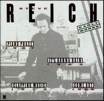 Early Works Double Edge; Russ Hartenberger; Steve Reich (Nonesuch)
Early Works Double Edge; Russ Hartenberger; Steve Reich (Nonesuch)
"It's Gonna Rain" and "Come Out" are tape pieces from 1965 and '66 that layer speech samples. There's a political element to them -- the former samples a black street preacher's oration about the Apocalypse and the latter samples a Civil Rights era beating victim -- but their main interest is the way Reich builds towering edifices of rhythmic sound by looping short phrases over themselves. He soon transferred elements of this approach to instrumental music; in "Piano Phase" (1967), two players start playing a pattern in unison, but one deliberately shifts tempo while the other stays steady, putting them out of phase more and more; it's mechanical music for flesh-and-blood performers, but as minimal as its components are, it"s quite a difficult piece to coordinate (as I learned first-hand back in my college days). This problem was solved by slightly altering the technique to have the players move out of phase in steady values of entire beats at a time, as in 1972's percussion duo "Clapping Music," wherein one clapper plays the exact pattern throughout while the other clapper shifts the rhythm by one beat every 12 bars until they are back in sync.
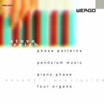 "Phase Patterns"; "Pendulum Music"; "Piano Phase"; "Four Organs" Ensemble Avantgarde (Wergo)
"Phase Patterns"; "Pendulum Music"; "Piano Phase"; "Four Organs" Ensemble Avantgarde (Wergo)
More early works here, including another performance of "Piano Phase." Influenced by John Cage and LaMonte Young, "Pendulum Music" (1968) is not a notated work, though it is, like the phase pieces, determined by a process. Four microphones are suspended within an array of amplifiers and speakers, then set in motion (hence the title). The shifts in feedback as they move in space create the music. Results differ; three versions are offered here. It's a bit like a phase piece, as the rhythms diverge and open out. The feedback is not loud squealing, but instead sounds like synthesized pitched percussion, setting up and varying simple melodic patterns. "Phase Patterns" (1970) is for four electric organs, but despite its title works differently from "Piano Phase." The focus is more on the rhythmic patterns, and it's less a process piece than a composed piece requiring more normal compositional decisions, anticipating the music Reich would write later that decade. Rather than shifting a fixed pattern, the patterns evolve, with motivic breaks clearly defining sections. The effect is still repetitive and meditative, however. "Four Organs" (1970) adds maracas and is built on the same principles.
 Drumming Cornelius Cardew, James Preiss, Steve Reich, Steve Chambers, Timothy Ferchen, Bob Becker, Russ Hartenberger, Ben Harms, Glen Velez, Joan La Barbara, Jay Clayton, Leslie Scott (Deutsche Grammophon)
Drumming Cornelius Cardew, James Preiss, Steve Reich, Steve Chambers, Timothy Ferchen, Bob Becker, Russ Hartenberger, Ben Harms, Glen Velez, Joan La Barbara, Jay Clayton, Leslie Scott (Deutsche Grammophon)
Reich, who had studied jazz drumming in his teens, became fascinated by African and Balinese drumming; in 1971 he spent five weeks in Africa and was tutored by Ghanian master drummer Gideon Alerwoyie. Then came this important transitional piece, Reich's last to use phasing and his first to show concern for orchestration in its shifting combinations of timbres (he even uses voices as percussion). His treatment of rhythm becomes more flexible and complex, which allowed the scale of the work to expand considerably (it's usually between 80 and 90 minutes long, though choosing to take fewer repeats has knocked it down by as much as 30 minutes) and also allows for more variety, though the growth of the patterns is still highly organic. This is a landmark of avant-garde music, and was very well received at its premiere, in contrast to the outrage that greeted "Four Organs." Drumming has had at least six recordings, of which this was the first.
 Music for 18 Musicians Steve Reich and Musicians (ECM)
Music for 18 Musicians Steve Reich and Musicians (ECM)
Another landmark, written in 1974-76; it could be said that this is where Reich's music became Post-Minimalist, because the unfolding of the structure is less rigid. Eleven chords are played, then eleven pieces are constructed on those chords. The textures that make Reich's music attractive no longer needed to be justified by the strict systems of the past -- and he added more textures as he expanded his instrumentation, which here includes violin, cello, and two clarinets (doubling on bass clarinet). He also added vastly more harmony; this piece sounds much less static than anything he'd previously done. This is the first of five recordings. Music for a Large Ensemble (1978) and Octet (1979), also highly worthy pieces, work with the same ideas.
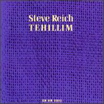 Tehillim Steve Reich and Musicians; George Manahan (ECM)
Tehillim Steve Reich and Musicians; George Manahan (ECM)
One of the vocal masterpieces of the 20th century, this 1981 work is Reich's first published text-setting vocal piece, setting excerpts of Psalms 19, 34, 18, and 150 (in Hebrew) for four female vocalists, chamber orchestra, and percussion. The underlying percussion beats are highly syncopated and usually steady, but the actual meters in the various sections change frequently, often measure-to-measure, as Reich adheres to the rhythms of the words (he had begun studying cantillation in Israel in 1977). And, accommodating the texts, the twisting, spiraling melodies are much longer than in Reich's earlier music. His usual canonic wizardry is frequently deployed, with the first movement particularly dazzling in its complex vortices. More startling are the homophonic sections, which serve as strong contrasts, and the third movement, Reich's first published slow movement.
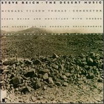 The Desert Music Steve Reich and Musicians with Chorus and Members of the Brooklyn Philharmonic/Michael Tilson Thomas (Nonesuch)
The Desert Music Steve Reich and Musicians with Chorus and Members of the Brooklyn Philharmonic/Michael Tilson Thomas (Nonesuch)
Maybe I should have included Reich's 1993 opera, The Cave, instead of this 1984 work that more or less expands on the techniques of Tehillim, but I have a great fondness for The Desert Music, which sets poetry of William Carlos Williams in absolutely entrancing fashion, full of majestic beauty.
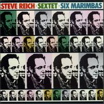 Sextet; "Six Marimbas" Steve Reich and Musicians with members of Nexus and the Manhattan Marimba Quartet (Nonesuch)
Sextet; "Six Marimbas" Steve Reich and Musicians with members of Nexus and the Manhattan Marimba Quartet (Nonesuch)
This isn't as historically important as the other albums on this list, but it's strikingly attractive music, most notably the sound of bowed vibraphone in Sextet (1985). "Six Marimbas" is a 1986 recasting of 1973's "Six Pianos," making it both more practical to perform and more fun to watch.
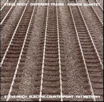 Different Trains/Electric Counterpoint Kronos Quartet; Pat Metheny (Nonesuch)
Different Trains/Electric Counterpoint Kronos Quartet; Pat Metheny (Nonesuch)
The Grammy-winning Different Trains (1988) combines string quartet and tapes containing very short interview excerpts and the sounds of trains, bells, and sirens; the music's melodies are derived from the speaking voices. The subject matter is dark, as the Jewish Reich contrasts his childhood train rides (going between divorced parents on opposite coasts) with the trains that took European Jews to concentration camps, giving the three-movement piece an innate emotionality and socio-political stance. As a side note, Reich put the taped sounds into a digital sampling keyboard for easier use, making this one of the first classical pieces to use that equipment. These ideas were explored further in the aforementioned The Cave. Electric Counterpoint is scored for ten electric guitars and two electric bass guitars pre-recorded separately by one performer. An eleventh guitar part is played live against the combined recording of the other parts. (There is also a version for complete real-time performance by multiple guitarists, but Metheny's distinctive tone is preferable.) Electronic group The Orb sampled part of the third movement for their extended piece Little Fluffy Clouds.
 You Are (Variations); Cello Counterpoint Los Angeles Master Chorale; Maya Beiser (Nonesuch)
You Are (Variations); Cello Counterpoint Los Angeles Master Chorale; Maya Beiser (Nonesuch)
Reich got his degree in Philosophy at Cornell, and You Are (Variations) (2004) is definitely a philosophical work, even quoting Ludwig Wittgenstein. The four movements alternate English and Hebrew, quoting Rabbi Nachman of Breslov (a Hasidic mystic), Psalm 16, Wittgenstein's Philosophical Investigations, and the Talmud. Reich says, "Starting out, I made an harmonic ground plan with a short cycle of chords that would serve as the underpinning for all the variations...[but] I started to vary the harmonies...they departed further from the original ground plan. I frankly enjoyed this immensely since I was following spontaneous musical intuition." Yes, Reich goes wild here, and it's utterly exhilarating, but still thoroughly Reichian. The effect suggests a much freer take on the musical ideas of Tehillim and The Desert Music. Cello Counterpoint (2003), for eight cellos (here overdubbed by Maya Beiser), is also very freely constructed and, even using technology, a virtuoso showpiece of sorts; it's also much darker in timbre than the vast majority of Reich's music due to the instrument's range.
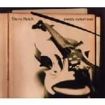 Daniel Variations Los Angeles Master Chorale/London Sinfonietta/Alan Pierson (Nonesuch)
Daniel Variations Los Angeles Master Chorale/London Sinfonietta/Alan Pierson (Nonesuch)
Daniel Variations (2006) is in memory of Daniel Pearl, the American journalist murdered in Pakistan by jihadists in 2002. It combines text from the Biblical book of Daniel and Pearl's words from the video his captors released and from an off-the-cuff comment Pearl (himself an amateur fiddler) made referencing the title of a song played by the jazz violinist Stuff Smith, "I Hope Gabriel Likes My Music." The words are sung by sopranos and tenors (Los Angeles Master Chorale), while the instrumental forces (including members of the Steve Reich Ensemble) are two clarinets, four vibraphones, percussion, four pianos, and string quartet. The idiom is similar to The Desert Music. While there is tension in the first three movements, and knowledge of the tragedy grants huge emotional import to otherwise innocuous utterances, ultimately the half-hour work is a celebration of the spirit of Pearl, and that comes across in the finale. This CD also includes the 22-minute Variations for Vibes, Pianos & Strings (2005), played by the London Sinfonietta under Alan Pierson. For three string quartets, two pianos, and four vibraphones, it is similar in tintinnabulatory brightness to much of Reich's mature instrumental work featuring vibraphones. It's in three movements, the outer ones fast and sparkling, with distinctive asymmetrical propulsiveness from the accents of the pianos, the middle slow and pensive, emphasizing the strings more.
